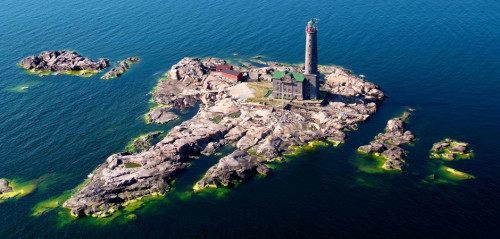
Bengtskär Lighthouse
Visiting Bengtskär lighthouse is one of those especially Finnish experiences that are worth the effort. It’s a working lighthouse far out to sea on a small islet in the Baltic Sea where you can stay as a guest. Bengtskär is the tallest lighthouse in Scandinavia and is an impressive national landmark which has also played an important role in Finnish history, occupying a place in the hearts of Finns akin to that of the Alamo in the hearts of Americans (see the section on the 1941 Battle of Bengtskär further down this Post). Towering 52 meters above the sea, the Bengtskär lighthouse’s massive stone structure has for nine decades provided a safe passage to the thousands of vessels which ply the waters of the Gulf of Finland.
Staying overnight on Bengtskär is a unique experience, located as this island is on a small, isolated and treeless rock (only about 2 hectares in size) twenty-five kilometers southwest of Hanko, at the entrance to the Gulf of Finland. Over millions of years the seas and the glacial ice sheets that once covered all this area have shaped the rocks into gently rounded curves. In small indents and holes in the rock you can find birds’ nests, hundreds of them are inhabited by a large bird population over the summer. The weather is always changing – it can be completely calm and then within minutes large waves are breaking on the shoreline. After the day-trippers leave, there is nothing but you, the lighthouse, the waves, the local birdlife and a small number of other over-nighters (the lighthouse has 6 guest rooms each of which can sleep up to 4 people) – the island is the southernmost inhabited place in Finland and the nearest village, Rosala, is some 18 kilometers to the north.
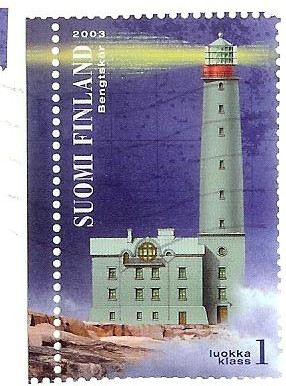
Finnish stamp showing Bengtskär lighthouse
What can you do if you stay on Bengtskär? Roam around the island. Enjoy the varied birdlife. Absorb the views of the sea. Relax in your room (every room has a sea view) or join your fellow guests in the common living areas. Enjoy the peace and quiet of this isolated outpost. There’s also a small sauna (of course – this is Finland after all) built from the local granite. And if you’re prepared to scale the 252 steps of the lighthouse tower (which you’re allowed to do, day or night), you’ll be rewarded with breathtaking views of the sea. You can also absorb the history, particularly from WW2 where some pitched fighting occurred between the Finnish and Soviet armies over this small piece of rock (there’s an exhibition within the lighthouse with details of the Bengtskär battle and the lighthouse building still has scars from the battle that was fought here – see some of the photos towards the end of this Post).
The two Cafés in the Lighthouse serve Breakfast, Lunch and Dinner, prepared with local Finnish ingredients and including beef, chicken, fish and vegetable dishes, not to mention dessert and plenty of tea and coffee. Reservations are requested for both lunch and dinner. For overnight guests, Breakfast is included in the room price.
You can read more about Bengtskär, it’s location, how to get there and what it’s like to stay there (and what it costs) as well as it’s history below. You might think it would be a bit boring but once you’ve stayed there, you’ll more than likely wish you’d booked a room for more than one night! On Bengtskär, you really are “away from it all.”
Location and Getting There
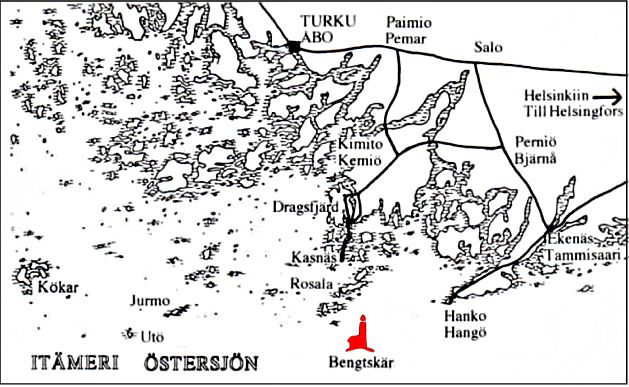
Bengtskär & South-west Finland
Bengtskär is twenty-five kilometers southwest of Hanko, at the entrance of the Gulf of Finland and can be reached by boat from either Kasnäs or Hanko. The shortest and safest sea route to Bengtskär goes through the archipelago from Kasnäs to Bengtskär and takes about an hour. Travelling by car, the port of Kasnäs is about 200 km from Helsinki. You can drive either through Tammisaari or Salo, but make sure to turn towards Kemiö when you reach Perniö. From Turku, the distance is approximately 100 km. Approximate driving times are 1.5 hours from Turku, 2.5 hours from Helsinki and 3+ hours from Tampere.
Daily cruises and charters from Kasnäs and Rosala can be booked by phone +358-2-4667227 or by e-mailing info@bengtskar.fi. (See the Bengtskär booking-page for more information).
While you can travel by boat from Hanko, the trip to Bengtskär is largely across the open sea and is far less scenic that that from Kasnäs, which wends its way through the islands of the archipelago.
Daily cruises from Kasnäs in 2013 (1 June to 1 September): Over the summer, daily cruises from Kasnäs depart every day to the following time-table:
- Depart Kasnäs 11.00am – arrive Rosala at 11.30am – Time spent at Rosala is 1.45 hours
- Depart Rosala 1.15pm – arrive Bengtskär at 2.00pm – Time spent at Bengtskär is 2.5 hours
- Depart Bengtskär 4.15pm – arrive Kasnäs at 5.30pm
The price of 57 € (children 28,50 € ) for the 2013 season includes boat transport, lunch at the Rosala Viking Centre ( Pike-perch soup, archipelago bread and coffee) and entrance fees with guided tours at the Viking Centre and at Bengtskär. Payment is made on the boat or at the Viking Centre. Cash, debit cards, Visa and Master / EuroCard are accepted. The boats used for this cruise are Linnea ( max 40 persons ), Minandra ( max 40 persons ) and Ocean ( max 24 persons ). Boats can be fully booked in the summertime, so it;s highly recommended that you make a reservation in advance.
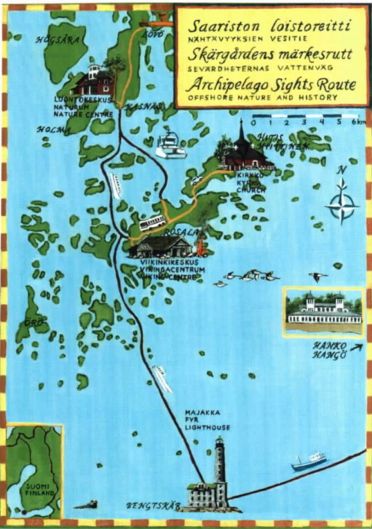
The ferry route from Kasnäs to Bengtskär
Parking at Kasnäs: There is free parking for Bengtskär travelers – the parking is on the left hand side of the road approximately 100 m before you reach the pier. It is locked, and you will receive the entry code when booking.
Weather: If the weather prevents landing on Bengtskär, the boat transfer is cancelled and you can visit the Viking Centre by the car ferry that departs from Kasnäs at 12.00 noon. The car ferry is free of charge. Guiding and lunch at the Viking Centre costs 18,00 / 9,00 euros. The Car Ferry time-table can be found here. If you book through Bengtskär, they will contact you by telephone regarding a cancellation either the day before or on the morning of the departure day. This happens on average about 1-2 days per month through the summertime.
Charter Boats from Kasnäs: There are a dozen boats that can be chartered from Kasnäs and Rosala to Bengtskär from May through to September. Charters can be booked through Bengtskär Ltd. The boats vary in size, the smallest carries 10 and the largest (the Linnea and the Minandra) 40 passengers. The cost of chartering a boat is higher than the
daily cruise trip as the boat is reserved for your group only. The time-table is planned according to your group’s needs. Contact Bengtskär Ltd (by phone +358-2-4667227 or by e-mailing info@bengtskar.fi. See the Bengtskär booking-page for more information) and they will plan a day tailor-made for you and your group!
Cruises from Hanko: The M/S Summersea sails from Hanko, leaving from the charter quay in the Eastern Harbour daily from 15 June to 18 August through Summer 2013.
- Departure from Hanko: 11.00am – Arrival at Bengtskär: 12.30
- Departure from Bengtskär: 3.00pm – Arrival at Hanko: 4.30 (2.5 hours at Bengtskär)
Cost for adults is 55€, children (4-14 years) 23€ including lunch, guide and entrance fee at Bengtskär (there is a discount for families). There is a café/restaurant on board the M/S Summersea, which can carry up to 155 passengers. Advance bookings are recommended and can be made with Marine Lines (phone +358 (0)400 536 930, myynti@marinelines.fi and website at http://www.marinelines.fi)
Visiting Bengtskär outside the Summer Season
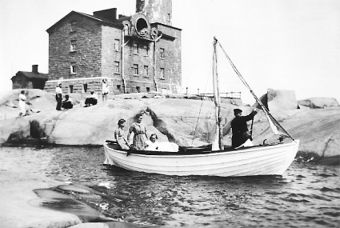
Bengtskär ferry service -circa 1906
Before and after the summer season there is some traffic to Bengtskär as long as there is no ice. The lighthouse is heated all year and there is service traffic in wintertime. The passenger boat traffic ends in end-September.
In weather circumstances where a boat cannot sail to Bengtskär, one can land there by helicopter. The trip takes only 25 minutes from Helsinki. At the moment Bengtskär does not book any visitors from October through to April, although the booking office is open during the winter from Monday to Friday between 9 am – 2 pm or by emailing Bengtskär at info@bengtskar.fi
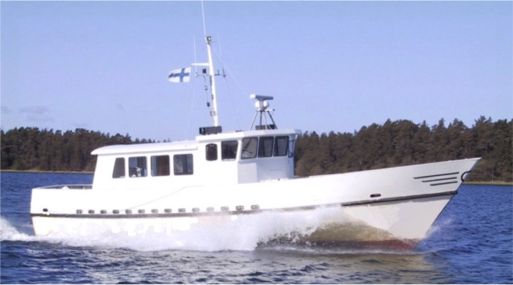
Visit Örö with Wilson Charters on the MS Linnea
Accommodation at Bengtskär
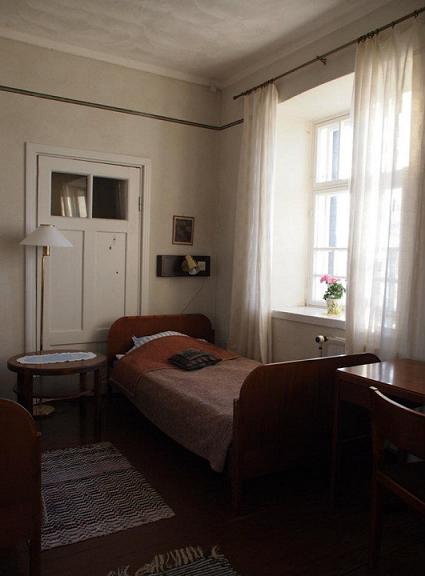
Bengtskär hotel room
From April 30th to September 30th, Bengtskär Lighthouse is open for over-night stays every day of the week. Before June 1st and after August 31st Bengtskär only books weekdays for groups that book all 6 rooms – but individuals or small groups can book rooms on Fri-Sat and Sat-Sun nights during May and September as well. Please note that the booking vacancies are not updated online regularly. For up-to-date information on vacancies and booking: Call +358-2-4667227 or contact Bengtskär at info@bengtskar.fi.
Six lighthouse keeper’s rooms have been converted to hotel rooms while retaining the original spirit of the lighthouse environment. For 2013, the price for a night is 64-110€ / person depending on the number of people per room (1 person 110€, 2 persons 86€ / person, 3 persons 75€ / person, 4 persons 64€ / person), half price for children 4-14 years. The price also includes breakfast and use of the sauna. The cost of boat transportation and other meals is in addition to the room/person charge. See Bengtskär’s price list.
Price for one night during the summer period 1 June – 31 August 2013 based on 2 person room occupancy:
- Round trip by boat including entrance fee, visit to the Rosala Viking Centre and lunch en route @ 57€ per person
- Accommodation including evening sauna and breakfast @ 86€per person
- Dinner and lunch on the second day @ 41€ per person
- Total cost 368€ (184€/ person )
Nature on Bengtskär
Bengtskär is a small barren island of only two hectare’s located out at sea and with very spare vegetation – most of the island is bare granite rock with small rock pools and consequently, the local fauna consists largely of birds. Trees and shrubs do not grow naturally on Bengtskär although there are two rather stunted gooseberries which the lighthouse repair crews planted in the mid 1990’s. Bengtskär plants are typical of the outer islets of the archipelago are mostly low-growing grasses and weeds along with ferns and lichens.
The island has plenty of rock pools of different sizes, holding both sea and rain water. A wide variety of sealife lives in these pools, while storms also wash fish into the pools where they often remain. The rock pools also hold Bengtskär’s most permanent residents, frogs and toads – and these are found in abundance on the island. There are no snakes on the island, although the neighbouring island does have these. At the end of July 2000, a small viper was found dead on the northern shore of Bengtskär but this probably came from Dömmaskäristä and was washed up on the beach.
The only permanent mammalian species on the island is the field vole. Since it has no enemies apart from random owls, visiting tourists and their dogs), there are occasional surges in their population. The summer of 1999 was such a year at Bengtskär: there were hundreds of Field Voles who ate almost all of the island’s green vegetation. Voles were domesticated to eat from the hand, and any food tossed to them by visitors disappeared right away into hungry mouths. More ingenious voles in search of food found the lighthouse potato store. During the fall of that year the vole population plummeted and in the spring of 2000 only one field vole was spotted in the yard.
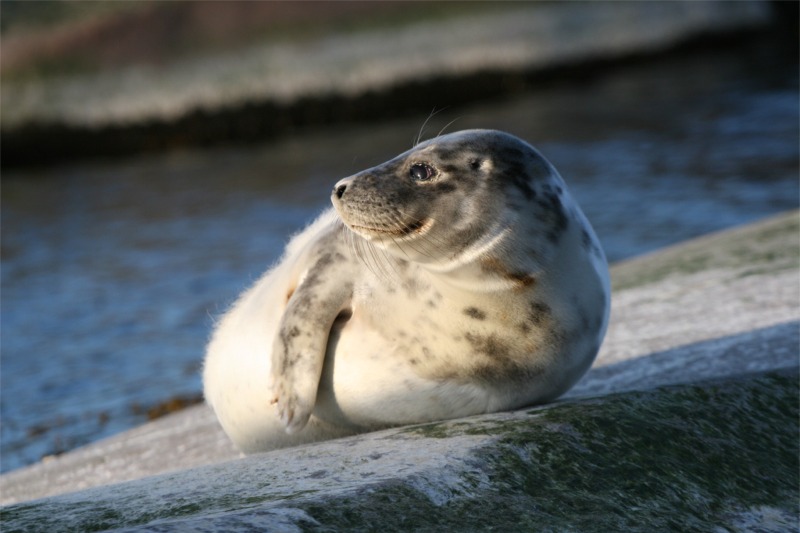
A resident at Bengtskär – Seal in April
Seals are seen at Bengtskär on a regular basis. The gray seal is common and on calm spring and summer days can be spotted in nearby waters. Young seals are also found from time to time and, while much less common, ringed seals can sometimes be seen.
Bird life on Bengtskäris closely monitored. with a serious bird watching effort begun in the spring of 1972. While Finland has about 430 species of birds, about 250 of which nest in Finland, only four species nest on Bengtskär – although nearly 200 bird species have been spotted on the island. The most common nesting bird on Bengtskär is the common eider duck, with approximately 20 Eider ducks nesting before the end of April. During the spring migration (April) and the autumn migration (August), tens of thousands of eider ducks may be seen around the island.
The second most common nesting bird is the House Martin, the number of pairs varies from 10 to 20. House martins nest in the top of the tower, under the eaves, and also in the other buildings. A White Wagtail couple has also been seen nesting. Bengtskär is a good place from which to observe the movements and migrations of sea birds. The start and end of the spring and autumn migrations can see easily because there are only four nesting bird species. Waterfowl are common on the island – the great crested grebe, whooper swans, geese and dabbling ducks, sotkat, sea ducks and mergansers can all be spotted. Spring and Autumn migration sees the migration of Arctic seabirds with geese, tundra and forest geese, long-tailed ducks and black birds. The cormorant is now also seen in Bengtskär waters while rare water birds seen on the island include the gray duck, Steller’s eider. and a grey heron.
Birds of Prey seen on Bengtskär include Hawks and Goshawks, while Sparrowhawks and Merlin’s prey on small birds and other prey on the island’s voles. White-tailed Eagles are now seen almost on a daily basis, while golden eagles are seen during the autumn migration. The endangered peregrine falcon has also been spotted. Almost all common wader species seen in Finland can be seen Bengtskär enjoying the beaches and rock pools. Seagulls can also be seen in plenty at Bengtskär with migrating gulls and terns numbering in the hundreds and in late autumn, in the thousands. The rare sandwich tern is now seen at Bengtskär each year while Auks and guillemots are common in the waters of Bengtskär, with the Guillemots often moving in flocks to feed. All five pigeon species found in Finland have also been seen at Bengtskär while owls are also now seen. Kingfishers are also now seen.
All in all, Bengtskär is certainly an interesting place to do some bird-spotting and watching, even for those who have never tried this before. It’s quite fascinating getting up close with a wide range of bird-life and it’s certainly one of the attractions of visiting Bengtskär.
Another attraction of course is for those interested in the history of Bengtskär.
The History of Bengtskär
Construction of Bengtskär
The 19th century recognition-beacon on the Isle of Bengtskär
Up until the early twentieth century, the seas around Bengtskär and the islands of Hitis and beyond were the site of many shipwrecks. A beacon was built on Bengtskär in the nineteenth century but it was small and visibility from the sea was limited due to its low height. With the growth of trade and shipping on the nineteenth century, plans were drawn up for an immense Baltic lighthouse at Bengtskär. At the 1900 Paris World Exhibition, architect Florentin Granholm unveiled his design for this unique lighthouse, a design that met with admiration and considerable critical acclaim. However, financial funding for the building of the lighthouse was only forthcoming when the steamship Helsingfors foundered and sank in the Gulf in January 1905. After this tragic event, the Imperial Senate approved the funds needed for construction to begin.
Construction commenced in early 1906 with granite from the island itself quarried and used for the building and some half a million bricks shipped over. By June 1906, 120 workers were busily engaged in Bengtskär`s construction. A special petrol lantern, designed and built in Paris, was brought to Bengtskär, installed in the lighthouse tower and lit for the first time on the nineteenth of December 1906. The beam of light flashed out three times every twenty seconds and could be seen clearly for twenty nautical miles. In winter 1907 a massive seven meters long foghorn was installed in the attic of the living quarters. When sounded, the foghorn could be heard for fifteen nautical miles! While useful for seamen, the noise was a trial to the lighthouse keepers who lived below.
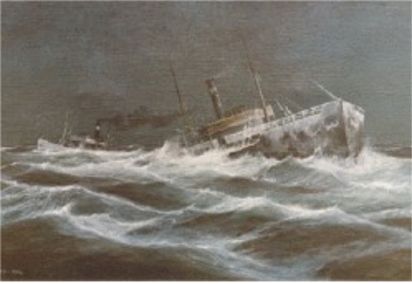
The steamship Helsingfors sinking – a catalyst for the construction of the Lighthouse
Once construction was complete, the Lighthouse itself was staffed by five men – a master lighthouse keeper, a machinist and three assistant lighthouse keepers together with their families who all occupied the living quarters. Initially fifteen people, over time and with the growth of the families the population increased until the 1930´s, when there were forty people living on Bengtskär. Life on Bengtskär was governed by the weather. When calm, it was possible to fish, shoot sea birds, hunt for seals or row to the nearest village for fresh milk and food. Relatives and friends visited and the pilot ship would bring fresh water, petrol and other provisions. On the other hand, when storms raged and heavy seas lashed the rocks, the island became too treacherous for outside activity and everyone would remain inside the strong walls of the lighthouse.
In August 1914 the First World War began and the lighthouse men and their families were evacuated to the mainland, with the lantern placed in storage. During that same year, two Imperial German Naval cruisers, Magdeburg and Augsburg, bombarded the lighthouse, which was only slightly damaged. By the summer of 1915 the lighthouse men and their families had returned to Bengtskär. However, with the Gulf of Finland being heavily mined, it was not until 1919 that the surrounding seas were declared safe for shipping and the light was lit again. Following the end of WW1 and Finnish independence, Bengtskär was again an important lighthouse and the number of children on the island grew so large that a teacher was brought from the mainland to look after their education.
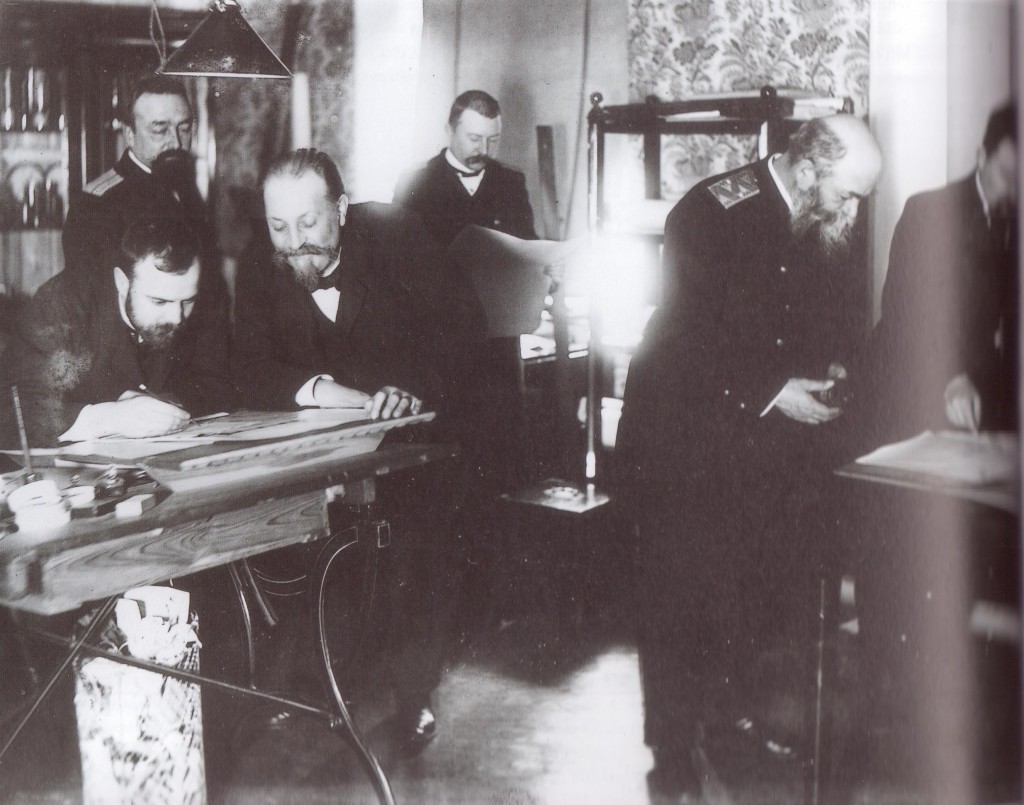
Design Office for the Bengtskär Lighthouse
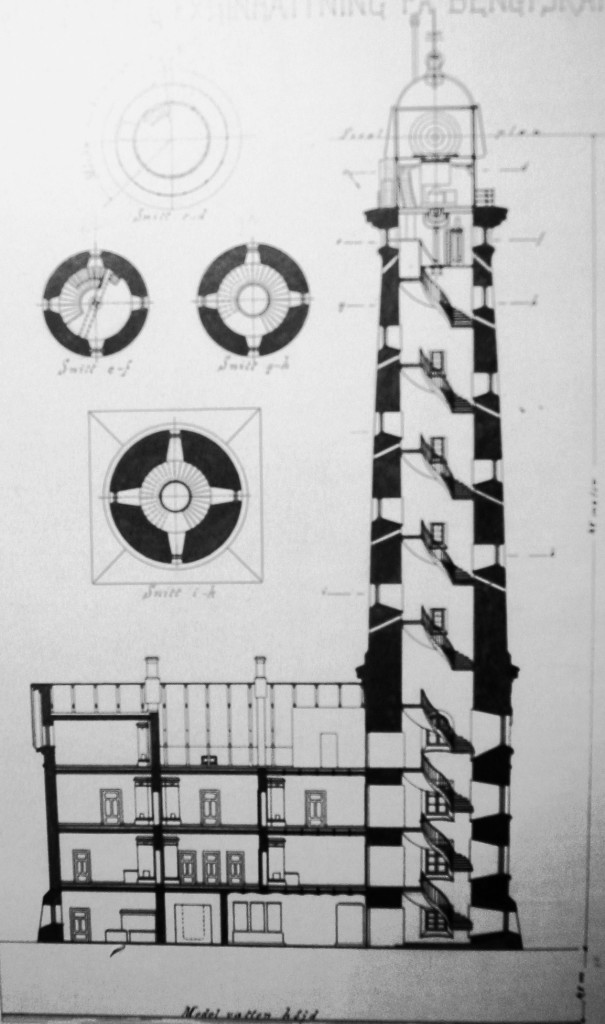
Bengtskär lighthouse plan 1897
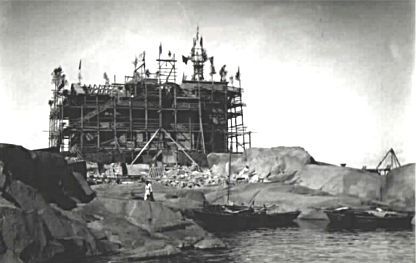
Bengtskär in 1906, Constriction on the main building
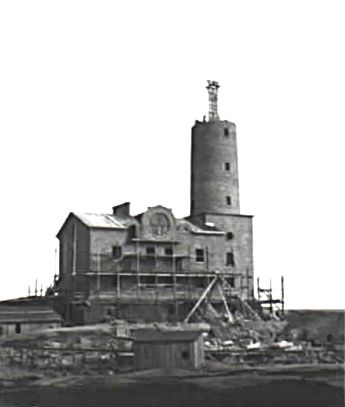
Bengtskär in 1906, Construction well underway
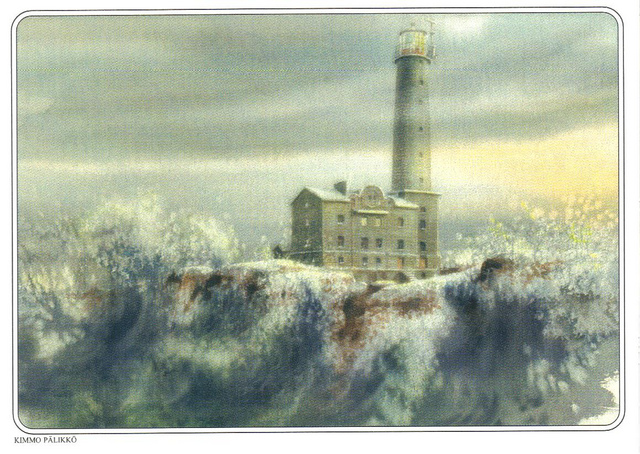
Bengtskär – an early postcard
The Winter War and the Soviet occupation of Hanko
In November 1939, Soviet Russian troops attacked Finland without a declaration of war – the 100 days long Russo-Finnish Winter War of 1939-1940 had started. Russia – like Germany – had always feared encirclement by hostile powers and one particular fear had always been the closure of the Gulf of Finland which gives access to Leningrad (now St Petersburg). This, and the physical proximity of the Finnish border to Leningrad were contributory factors to this Russian attack on Finland. After a bitter struggle in which the Finnish Army inflicted enormously disproportionate losses on the Soviet forces, Finland eventually signed a new treaty with the USSR in which the Karelian Isthmus and large areas of Eastern Karelia were ceded to the USSR while the promontory of Hanko with its commanding position on the Gulf of Finland was in Russian hands as a military base. A glance at the map shows that, combined with control over Estonia, the base at Hanko with its superb natural harbours allowed the USSR to close the Gulf of Finland to any naval force threatening Leningrad (it also allowed the USSR to blockade Finnish ports in the Gulf of Finland if they so chose.
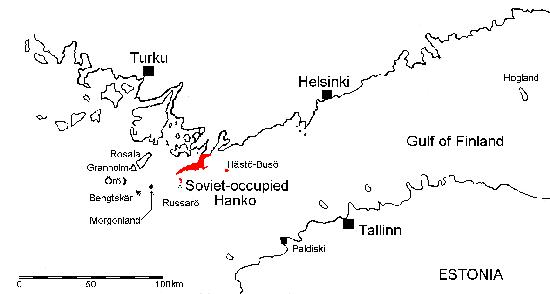
Map – The Gulf of Finland, showing Hanko, Bengtskar, and the other islands
The commander of the Soviet Hanko base was Maj. Gen Seregei E. Kabanov, with Arseni L. Rasskin as political commissar and Commodore Pjotr G. Maksimov as his Chief of Staff. Under their command, Soviet troops constructed extensive field fortifications on the landward side of the peninsula – faced by equally extensive Finnish defences — and proceeded to turn Hanko into a naval base for seaplanes and small naval vessels. They also built an airfield for fighters and bombers at Täcktom, just outside Hanko, though this was never a great success, being prone to becoming waterlogged in spring and autumn. Then, in June 1940, the USSR gained control of Estonia, allowing Soviet forces to dominate the Gulf of Finland from both sides. The longed-for gates to Leningrad were now in place. The Hanko base was occupied by about 30,000 Soviet soldiers, and constituted a large foreign force on Finnish soil in 1941. The strategic importance of Bengtskär quickly became apparent as Finnish troops on the island could easily monitor Soviet activities in Hanko from the lighthouse tower.
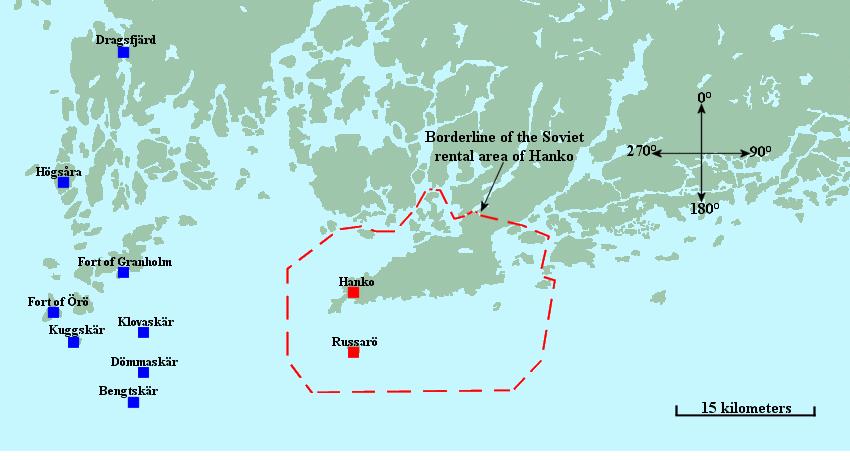
The Hanko area, map showing the Russian-occupied zone, Bengtskär and other places and forts
The natural harbours of Hanko are surrounded by a ring of small islands and any approaching craft must pass through one of the narrow gaps between them. This made the job of defending the port very easy: it was merely necessary to mount artillery pieces on each island to dominate the gaps; remnants of these defences remain today. In addition, the Russians took over and restored the (destroyed) former Finnish coastal artillery positions on the islands of Rusarö and Hästö Busö, equipping them with 130mm artillery batteries. In September, 1940, these batteries were supplemented by three 305mm railway guns (‘Obuhov’ type-guns, as fitted to old Tsarist-Russian battleships) brought over from Leningrad. The Russians also flew in aircraft to base at Hanko – apart from a few seaplanes, these were mainly Polikarpov I-16 single seater fighters and Polikarpov I-153 biplane fighter-bomber – in all, around 60 aircraft.
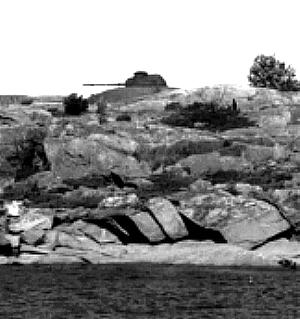
Remnants of the Russian defences around Hanko remain today – here an emplaced T-34 tank
However, Hanko’s natural defensive features are also a weakness. Due to the relatively shallow water (an average depth of 5 metres) and the numerous rocks and shoals, there are only a limited number of possible routes into and out of the port. These possibilities were reduced by the Finnish presence on the surrounding islands. To the west is the Hanko archipelago, a mass of islands, many of which were fortified by the Finns and some of which were major naval bases. To the immediate east, another group of islands was similarly occupied and fortified. Also, from the Russian point of view, all of the Finnish coastline, from Hanko almost to Leningrad, was a hostile shore. Consequently, to support Hanko as a base, Russian vessels had to enter and leave the port on a north-south course, bringing them in sight of several of the western group of Finnish-held islands – in particular, Morgonland and Bengtskär – and within range of Finnish coastal artillery batteries on the island of Örö.
The Continuation War – the Soviet Union again attacks Finland
Anticipating either a German attack on the Soviet Union or a another surprise Russian attack on itself, Finland again mobilised its army on June 17th, 1941. On June 22nd, Germany commenced Operation Barbarossa, launching the German attack on the Soviet Union. Finland immediately declared its neutrality, although German planes bombing Leningrad were permitted to refuel at Finnish airfields and German troops were stationed in northern Finland ready to attack Murmansk in the Arctic.
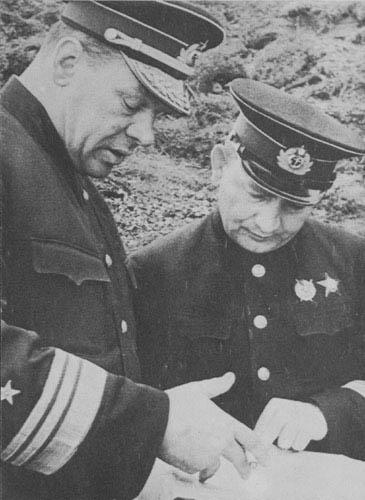
Lt-Gen S Kabanov, commander of the Soviet garrison in Hanko
Following repeated Russian air-raids on several Finnish towns and cities without any declaration of war, Finland formally declared war on the USSR on the 25th of June and joined in the German attack as, in a common Finnish expression, ‘co-belligerents’ rather than as allies. The Soviet enclave in Hanko was now threatened: the Germans were advancing rapidly up the Baltic coast and if Estonia were to be lost, only Hanko would remain, leaving only half a gate to close the naval route to Leningrad.
The Finns were determined to get the Russians out of Hanko, the Russians just as determined to stay. At one time, the Finns considered re-taking the area by force and with this in mind, the German 163rd Division was brought from Norway to join with the Finnish 17th Infantry Division. However, the operation was abandoned for fear of heavy losses and the opposing forces, while undertaking occasional artillery duels, settled down to static warfare.
On the seaward side, the picture was different: command over the seas of the Gulf of Finland was the reason that the Russians wanted Hanko in the first place – but the sea was also full of islands and most of those islands were full of Finns.The islands to the east of a line roughly north-south through Gunnarsären and Dodö were in Russian hands, those to the west, in Finnish. Many engagements were fought in the islands, often by canoe-borne commandos, and some islands changed hands several times. At first, many of these engagements were the consequence of ‘aggressive patrolling’ by the Finns and proved costly for minimal gains. These raids were eventually forbidden on the direct orders of the Finnish C-in-C, Marshal Mannerheim. The last major skirmish was on October 14th when the Russians tried – and failed – to take over Koholm, Stoskär and Løgholm (Långholm), islands in the archipelago due east of Hanko.
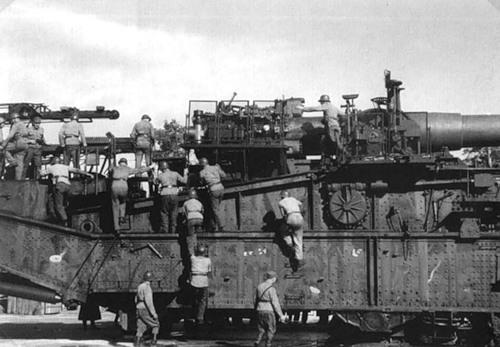
The gun in the photo is Soviet 305-mm railway gun TM-3-12 (305/52 ORaut for Finnish military), which was captured in Hanko / Hango peninsula after the Soviets had evacuated their base in December 1941.
On June 22nd (the start of Barbarossa) Russian batteries in Hanko opened fire without warning or any declaration of war on Finnish troops in the Hanko peninsula. Twenty Luftwaffe Ju-88’s later dropped 10-20t of bombs on Hanko and the German Navy laid two minefields in the Gulf of Finland – this was the first of a complex series of minefields laid by all parties involved. The German minefield seems to have been laid to prevent access to Hanko by a southern route and to ensure that all shipping remained within range of the Finnish coast. In fine weather, all Russian naval movements could be observed from Bengtskär, where a small Finnish force was able to provide valuable reconnaissance and target sighting in the renewed Finnish struggle against the Soviet forces holding Hanko. Bengtskär lighthouse offered an excellent observation from which to direct artillery fire from the island of Örö (where the Finns had a battery of two 305 mm and four 152 mm coastal guns) against Soviet land and naval forces.
For the first month of the Continuation War, the Russians tried aggressively and, initially, with much success, to protect their vulnerable sea routes into Hanko by driving the Finns out of the inshore islands. Once this was accomplished, Kabanov and his staff turned their attention to the islands in the open sea: first Morgonland and then Bengtskär.
The Attack on Morgonland
Morgonland is a small, flat island with a pond in the middle, lying a few hundred metres east of the agreed boundary between the Finnish and Russian sea areas. In 1941, the island belonged to the Hiitinen military sector which was defended by the 3rd Linnakkeisto (Fortification Battalion) of 4.RPr, the 4th Coastal Brigade, under the command of Maj. K-J Moring. Early in the Russian occupation, it was equipped with an undersea telephone line to the battery on Örö and to HQ in Rosala, 50 km away, and a small observation party was stationed there. At that time, the island had a concrete surveying tower which the Finns used for observation, allowing them to monitor not only naval movement but, to some extent, activity in Hanko itself. The island, however, was far from defensible and on June 16th, anticipating Barbarossa, the Finns withdrew their troops and mined the surrounding waters.
The Russians had long suspected that the Finns were using the island as an observation post and when Finnish destroyers shelled the Hanko water tower, airfield and the railway batteries with great accuracy their suspicions were confirmed: both Morgonland and Bengtskär were vital parts of the Finnish coastal artillery battery system. On June 25th, the Russians shelled Morgonland, destroying the concrete survey tower to the annoyance of the Hanko base commander who had had his eye on it for his own purposes. At the same time, the Russians shelled many other Finnish positions, causing many forest and scrub fires. Once the fires were well established, Russian aircraft strafed the fire-fighters. After June 25, artillery duels between the two sides became an almost daily occurrence.
On July 2nd, the Finnish commander in Örö, Maj. Moring, decided to re-occupy Morgonland and on July 6th, 1st Lt. Fred Luther (of whom, more later) was landed alone, apparently to reassess the situation. Luther’s report must have been favourable – on July 4th it was decided to replace the garrison on July 7th. However, Moring, concerned for his men’s safety, stipulated that the party should have their own boat with which to escape to Örö should the need arise. On July 8th, Lt. Luther was withdrawn and replaced by 1st Lt. Per-Erik Ahlblad, together with his second-in-command Cpl. Nils Ranta and privates Albin Törnqvist, Ernst Pihl, Torvald Samuelsson and Arvi Nyman, the latter being in charge of communications. They were equipped with one machine gun, one machine pistol, four rifles and a radio – though they were expected to maintain radio silence and use the underwater line. They lived in a tent in the middle of the island and had rations for a week. Their task was to direct artillery fire from Örö and they had a plotting table with direction and crude range measurement.
Towards the end of that week, the Russians realised that Morgonland was again being used to direct artillery from Örö and began intermittently shelling the island. The promised relief boat from Örö did not arrive on time and Ahlblad and his men began to be concerned. Nyman contacted Maj. Moring who assured him that they would be relieved and asked the men to be patient. Meanwhile, in Hanko, the Russians, encouraged by the ease with which they had driven the Finns from some of the inshore islands, decided to settle the problem of Morgonland and the other outer islands once and for all by an assault. Lt Shaikin of the Border Guards was given command and, in preparation for an assault scheduled for the night of July 15/16, the island was heavily shelled by artillery, causing the sparse vegetation to catch fire.
At about 23:00 on the night of July 15th, Pihl spotted two Russian boats leave Hanko on a direct course for Morgonland. News of the boats’ approach was signaled to Örö, where it was received by Cpl Koskinen in the message center; in response, Örö asked Ahlblad if he wanted artillery support. Apparently confident of the protection offered by the Örö battery, Ahlblad asked for fire to be held while the fire director was properly set up. Once this was done, Ahlblad gave the co-ordinates and called for fire. Nothing happened. On Örö, the battery commander, Capt. Lanramo, was not answering his telephone and without him, no permission to fire could be given. In desperation, Nyman insisted to his colleagues in the message centre that they go to Lanramo’s quarters and wake him by force. This they did, but Lanramo was not there.
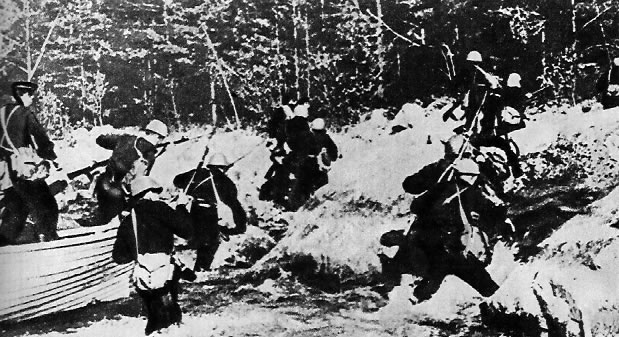
Soviet Marines landing on an island near Hanko
At 00:10 (now, July 16th) Nyman reported that the Russians were approaching the island and that they – the Finns – were preparing to fight. Sixty Russian marines came ashore by rowing boat on two sides of the island. At 00:18, Nyman reported that the enemy had landed and shots were heard over the telephone before the connection was cut. Shortly after, observers on Örö saw several starshells fired from Morgonland, though what these signified is not known. Now the situation on Örö degenerated into black farce: Maj. Moring, Capt. Lanramo’s commander, refused to fire because the telephone connection to Morgonland had been lost. However, at about 00:50, he apparently asked for a naval vessel, the minesweeper Muikku, to be sent to the island to assess the situation and, if necessary, evacuate Ahlblad and his men. It was already too late.
The Finns, facing odds of ten-to-one, resisted for less than an hour. Nyman – ultimately, the only one to return to Finland with the full story – was wounded. In the end the small Finnish force surrendered. The prisoners were apparently treated quite roughly by the Russians who at first refused to believe that there were only six Finns on the island and conducted an extensive search, forcing the prisoners to march ahead of them in case of mines. Eventually, the prisoners were blindfolded and taken by boat to Hanko. Once in Hanko, the prisoners were treated fairly well and at one stage were tricked into posing for a group photograph with their captors. The Russians exploited this opportunity to the full and used it to produce propaganda leaflets which were dropped in abundance over Finnish territory. The ultimate fate of Ahlblad and four of his men is not known. Nyman was taken to a work camp, Karaganda in Kazakstan, together with 320 other Finnish prisoners. Of the Morgonland six, only Nyman returned on 22nd November, 1944. Of the other 320 Finns at Karaganda in Kazakstan, only 28 returned. The minesweeper Muikku, dispatched at the request of Maj. Moring, reported that the island was deserted. No new garrison was installed. Subsequent accounts have questioned Moring’s actions: Why were Ahlblad and his men left without an escape boat? Why did Örö not open fire? Why did Moring not request assistance from naval forces which were operating in the area? The simple answer is that we do not know.
The Battle of Bengtskär
If the evidence about Morgonland seems fragmentary and confused, that for the Battle of Bengtskär is even more so. Even official documentary records are contradictory. What follows is based principally on Lt Luther’s testimony, corroborated by the signals records of the Örö message centre.
In June of 1941, Bengtskär had a garrison of six men and three or four civilian lighthouse keepers. Following the loss of the island of Morgonland, the best remaining observation post was Bengtskär, with its 52m tall lighthouse and it was decided that this position should be reinforced. On 20th July, Lt Fred Luther and 26 men of the 2nd Rannikkoiskukompania (Coastal Shock Company) were sent to garrison the island. They were armed with old Swedish Mauser rifles, machine-pistols, two heavy machine guns, hand grenades, and kasapanos (Swedish: buntladdningar – literally, a bunch of charges), a form of ‘satchel charge’ made from sticks of dynamite. These latter were to play a decisive part in the subsequent battle.
The men were apparently unhappy about their Swedish weapons, which were unreliable, and immediately set about stringing barbed wire and building emplacements. They also put a permanent lookout in the tower and had two sentries on patrol at night. On 23rd July, they were reinforced by a 20mm Madsen anti-aircraft cannon commanded by Cpl Nurmi and a three-man crew. Their closest support was from Örö, 13km away, which, together with a second battery on Granholm, had pre-arranged fire-plans for the island.
Encouraged by their success at Morgonland, the Russians decided that Bengtskär would be the next Finnish position to be eliminated. They first planned a bombardment by the railway batteries and by heavy bombers from air bases in Estonia but this was expected to be a lengthy process so again, a surprise assault from the sea was selected, this time with a demolition party to destroy the installations on Bengtskär – especially the 52m tall lighthouse tower. The plan was for a silent assault, the abduction of the garrison, the destruction of the lighthouse, and for the assault force to disappear without trace. The Russians were encouraged in this plan by reports from the interrogation of Lt. Ahlblad and his men which suggested that Bengtskär was only lightly guarded – which, at that time, it was.
However, in fine weather and daylight – and in July, night on Bengtskär lasts from about 23:00 to 02:30 – the island is almost impossible to approach unseen. Consequently, Russian plans called for a night attack in bad weather. In this respect they were lucky: the nights were quite misty, a condition made worse by smoke from fires which had been sparked by bombardments on shore and in some of the nearby islands. The command of the assault force was given to 1st Lt. P. Kurilov and senior politruk (commissar) Rumjantsev who commanded two groups of 30 men of a detachment, each of which was transported in an MO boat. A third boat was to carry additional supplies and a demolition squad whose task would be to destroy the lighthouse. The naval component was led by 1st Lt G. Lesjepekov. Overall, seven boats were involved: MO236 to 239 and MO311 to 313.
The Russians made various preparations for the forthcoming assault including laying mines around Bengtskär, making extensive air attacks on the two Finnish coastal battleships, Väinämöinenand Ilmarinen so that they had to be withdrawn to safety in the inner islands of the Gulf of Bothnia, north-west from Hanko. Lacking any heavy naval forces themselves in Hanko, these two old but, as we shall see, effective vessels were thought by the Russians to present a real threat to the operation. So too, in the event, were two even older Finnish Navy ships, the Uusimaa and the Hämeenmaa which formed Task Force Auvinen, named after the commander of Hämeenmaa. In addition, the Finns had a number of VMV boats – 32 ton wooden craft, capable of 20 knots and with excellent seagoing characteristics, but armed only with 20mm canon. They were not considered a match for the Russian MO boats.
On the night of the attack, July 25th 1941, Bengtskär was guarded by 37 men, plus at least three and possibly four lighthouse keepers. Early in the evening a German boat passed by but otherwise everything was quiet. Just before midnight, the two Russian attack squads embarked: one in PK238, Cdr Lt Beljajev, the other in PK312, Cdr 2nd Lt Jefimov. They were armed with light automatic weapons and grenades. They were followed shortly after by PK311, Cdr Lt Bubnov, which carried explosives, ammunition and other supplies together with the demolition squad. After them came PK239, Cdr 1st Lt Terestsenko, carrying Capt. Polegajev as overall flotilla commander. The flotilla went due south by Rosaro at around 00:40, then passing over some shallows, headed west so as to approach Bengtskär from the south. The weather was calm and warm, with an air temperature of 18°C, but visibility was poor due to the combined effects of mist patches and smoke from the forest fires. PK238 reached the southern promontory first, landing immediately below the terrace in front of the accommodation building.
On guard in the lighthouse tower was L/Cpl. Ryhänen. His suspicions had been aroused a few minutes earlier when he thought he saw movement on the waters. However, there had been a previous sequence of false alarms, caused by German patrol boats – and the MO boats bore a passing resemblance to a German Raumboote – which had failed to respond correctly to challenges. Ryhänen was reluctant to make a fool of himself again and he knew that his exhausted comrades, who had been stringing wire all day, were fast asleep and deserved to remain so. So, in accordance with orders, he challenged the boats by signal lamp. Instead of returning the correct response, the Russian boats simply repeated the sentry’s signal. Unfortunately, Ryhänen’s command of Morse was not good and he did not himself know the codes particularly well. He tried twice before his suspicions were thoroughly aroused and then descended the tower to alert Lt.Luther. It was now about 01:00 am.
Simultaneously, the Russians reached the shore, jumped onto the rocks, and began to spread out in a three-pronged attack. On the left, a group commanded by a Sgt Kibis secured the flank. The centre group, commanded by Kurilov and his Intelligence Officer, 1st Lt M. Belikov, had the lighthouse as their objective. The eastern group, under senior politruk (commissar) A.I. Rumjantsev probably had the Madsen canon and its adjacent AA guns as their objective. On the southern side of the island, Pvt Nystrand was on patrol. He saw nothing of the advancing Russians until the last moment when he ran to the tower screaming: “Ryssät! Ryssät!” (“Russkies! Russkies!“) after which he hid in the lighthouse cellar where he was later discovered and killed. What happened next is not clear. Someone woke Cpl Harry Bjelke and it seems that he may have responded faster than – or been awoken before – Lt Luther. Some versions have it that it was Laine (the lighthouse-master) who, having gone outside to relieve himself, saw the attackers and raised the alarm.
Cpl Esko Nurmi, together with privates Virtanen and Kajander, ran to the 20mm Madsen AA gun in its sandbagged emplacement. Nurmi and Virtanen began firing the Madsen at the Russian boats but Kajander panicked and hid among the rocks where he was later discovered by the Russians and bayoneted to death. Nurmi and Virtanen continued to fire the Madsen for some hours from their isolated position. Meanwhile Cpl. Bjelke, with Privates Eriksson, Gustafsson, and Åberg, ran out towards the outhouses and from there opened fire on the Russians’ flank. They continued to fire for about 30 minutes until Åberg was killed after which they were forced to withdraw back through the north door of the lighthouse. In the withdrawal, Eriksson fought a gallant rearguard action, firing with a light machine-gun from the open lighthouse at the pursuing Russians before being mortally wounded.
Apparently still dressing, Lt. Luther ran to the nearest window from where he called on his men to take up positions in front of the building, receiving a burst of machine-pistol fire in response. From there, he ran to the ground floor of the tower where three men were preparing to set up a light machine-gun on the terrace. Lt.Luther and the three men – Cpl Sandberg, Pvt Einar Holmström (the machine-gunner), and Pvt Gerkman – ran out onto the terrace in front of the Russians. Gerkman apparently died after killing a Russian hand-to-hand (and, some accounts say, teeth-to-anything-in-reach). Sandberg died beside Gerkman after receiving an ‘exploding bullet’ in the stomach.
Holmström went down when his machine-gun jammed. According to the more colourful accounts, he fell back into Luther’s arms murmuring: “Fullträff, pojkar!” (“Direct hit, lads!“). A hand grenade exploded beside them, knocking out three of Luther’s front teeth and wounding him in the right arm. Luther, the sole survivor, withdrew into the south door of the tower. Meanwhile, on the landing area, Rumjantsev’s group began taking fire from the flank – almost certainly from Bjelke and his men – and Rumjantsev himself was mortally wounded, along with his medical orderly. In fact, the Russians were not in as strong a position as it seemed. While they had good positions among the rocks and in the dead ground below the terrace wall, they needed to climb the 1.5m high wall (there are steps in the middle) and cross at least 30m of open ground between the terrace steps and the doors at the foot of the lighthouse tower. The Finns, on the second and upper floors of the building had all the advantages of height and a strong defensive position. It was at this point that there occurred one of those inspired actions that seem to happen in many desperate engagements and which decisively affect subsequent events.
The wounded Lt. Luther made his way to the designated dressing station, in the radio room on the third floor, where he found Pvt Anjalin – by all accounts, a very tall, powerful man – with one of the kasapanos (satchel charges) which he asked permission to throw into the dead ground below the terrace wall. Permission was immediately granted and Anjalin threw the charge which exploded and killed or wounded about 10 Russians. Amongst those killed or fatally wounded was Kurilov, leader of the central group and in overall charge of the operation. Now Lt Belikov, the I.O., took command. Anjalin was hit in the head by a Russian bullet and killed shortly after his heroic action.
According to the records, the duty watch in Örö received an alarm from the Bengtskär radio operator – Cpl O. Ryyppö, another man who distinguished himself in the battle – at 01:06. Ryyppö radioed a general alert to the surrounding garrisons and to naval patrols at sea and in harbour. For some reason, Sgt Koskelin, in command of the duty watch on Örö, failed to raise Bengtskär by short-wave radio. However, Ryyppö, on Bengtskär, managed to contact the staff headquarters in Hitis (on Rosala island, due north of Bengtskär and west of Hanko) telling them that Russian troops had landed and were as close to the lighthouse as the terrace wall. From Rosala, Maj. Moring ordered the batteries in Örö and Granholm to fire on the waters around Bengtskär, alerted the gunboats in Högsåra, and called for air support. The Örö battery opened fire at 01:26; the Granholm battery at 01:41. In contact with Hitis, Lt. Luther directed the fire onto his own positions with nothing more than a marching compass; miraculously, though the fire was devastating for the Russians, the lighthouse received no direct hits. Luther was rightly confident that he and his men were secure within the massive granite walls of the lighthouse and accommodation block which, after all, had withstood a lengthy German naval bombardment in 1914. The MO boats which had been circling the island, firing at the lighthouse with their 45mm cannons and AA guns, were forced to withdraw.
At about 02:00, three Finnish patrol boats, with a force of rannikkojääkäri (Finnish Navy Marines), now came inshore under heavy Russian fire and attempted to land reinforcements. This was not successful and at about 02:30 two of the boats withdrew into the mist while one remained. At about the same time, the two elderly Finnish gunboats, Uusimaa and Hämeenmaa, which were in transit to Örö, were ordered to divert to Bengtskär. Shortly afterwards, at about 03:00, three Russian boats (unidentified but presumably MO craft from Hanko with a similar complement of marines), tried another landing but were repelled and surrounded by Finnish patrol boats coming from the south and west. Shortly afterwards, a fourth MO boat arrived and Cdr M. Polegajev took command of Russian forces at sea.
Finally, a few Russians close to the tower made a desperate attempt to enter and succeeded. One of the defenders attacked Lt Kagalov with a knife but was overpowered, though not before mortally wounding the deputy commissar, Lt Kostritsa. The defenders retreated to the upper floors, leaving much of their ammunition and grenades behind. Lt Kagalov, in comically accented Finnish, called repeatedly upon the defenders to surrender. This subtle attempt at psychological warfare had no apparent effect. Surprisingly – or perhaps not, in the light of their lack of leaders – the Russians made only one further attempt to rush the lighthouse staircase, which is the only means of access to the tower and the accommodation block. At this point, the Finnish defenders were down to their last grenade; Bjelke asked the wounded Lt. Luther for advice. “Throw it!”, was the reply. The last grenade was thrown and several Russians were killed or wounded. The Russians made no further attempts to assault the second and higher floors but had they done so, they would probably have succeeded for the Finns now had no more grenades and were running low on ammunition.
At around 03:45, the Finnish gunboats Uusimaa and Hämeenmaa and the patrol boat VMV13, under the overall command of Capt. Lt M. Auvinen, arrived and began to drive the Russian boats away. At about the same time, Russian batteries on the island of Rossarö opened fire on Bengtskär but were subjected to counter-fire from the 305mm battery on Örö. Hämeenmaa took some hits, her chief engineer, Iilamon, was killed by Russian strafing and the firing system on at least one of the antique 102mm guns was damaged. The naval gunners however continued to fire by using a marlinespike and hammer to ignite the primer!
Meanwhile, the two Madsen gunners, Nurmi and Virtanen, continued their lonely battle, having almost certainly prevented the Russian demolition squad in PK311 from landing. With ammunition running low and with no hope of reaching the lighthouse (it was later to take Lt Kaikonen and his relieving force of sixty rannikkojääkäri over an hour to cross the same stretch of ground) Pvt Virtanen suggested taking to the sea and either swimming to their own boats or to the uninhabited islet of Dörmanskär, about 2km away. However, Cpl Nurmi had never before swum more than 20m and was afraid that the water would be too cold so he advised Virtanen, a strong swimmer, to go by himself. Virtanen jumped in, swam around the cape, and was rescued by one of the VMV boats. Shortly afterwards, Nurmi noticed three green Russian helmets behind a rock about 5-6m away – something which greatly increased his confidence in himself as a long-distance swimmer. Stripping off his uniform, Nurmi jumped into the sea and, despite being fired upon as he crested each wave, made it safely to Dörmanskär.
At about 04:00, three Finnish Fokker D.XXI fighters overflew the island, machine-gunning the Russian troops and approaching Russian vessels. Lt. Luther was wounded for the second time, taking a bullet through his left arm and shrapnel to the stomach. Though serious, the wounds were quickly stabilised and Cpl Bjelke took command of the fifteen or so survivors who retreated to the upper (i.e. third and fourth) floors of the accommodation block. By 04:30, the sun was well up and the battle continued in daylight, despite some residual fog banks and wisps of mist. VMV13, under Lt Valtasaari, approached the island and a squad of twelve men (with one machine-gun as their only heavy weapon) under 2nd Lt P. Åsvig, attempted a landing by rowing boat. Åsvig and a sailor were killed on the shoreline but the others, now commanded by 2nd Lt R. Pelkonen, successfully reached the island where they were pinned down, spending over an hour in the water. Though this group had little immediate practical effect on the battle, its effect on the morale of the men in the tower was enormous. Another sailor, R. Söderblom, bravely came out from VMV13 by rowing boat to take off the wounded, being himself wounded in the process.
Between 04:00 and 05:00, two further Finnish groups left Rosala and Örö to mount a counter-attack on Bengtskär. The first group, from the 4th Coastal Company in Rosala, under 1st Lt M. Kaikkonen, comprised 35 (or maybe 60) men in four patrol boats, converted from fishing craft. En route, one boat’s engine broke down and the craft had to be towed; they were also machine-gunned by Russian fighter-bombers but with no ill effects. The second group, under Lt Backlund, consisted of 41 (or maybe 23) volunteers from the Örö garrison, in three minesweepers. The force assembled in the shelter of Klovaskär island, close to Bengtskär, where Kaikkonen, who seems to have been in overall command, received orders to proceed with the operation. Shortly before 06:00, three Russian MO boats tried to approach from the south, with the apparent intention of evacuating the survivors, but were driven back by the Finnish gunboats. One Russian boat, PK238, succeeded in coming close to the shore but Uusimaa scored a direct hit from 4,000m and the Russian vessel exploded. VMV13 rescued 16 Russian survivors.
At 06:03, Kaikkonen’s force, protected on the flanks by the minesweepers Lahna and Muikku and four other motor boats which kept the enemy back with 20mm fire, landed on the eastern side of Bengtskär. A heavy machine gun was brought ashore and a firing position established but the machine-gunner was killed almost immediately and the weapon disabled. Within a few minutes, another was killed and three more men were wounded. Kaikkonen did not launch an immediate attack but crawled bravely forward to assess the situation before waving his men forward. Nevertheless, the attack proved much slower than expected because the Russians were determined to hold on and had to be subdued one-by-one as they hid among the rocks. After about an hour the relieving force reached the lighthouse – 30m from their landing point. From the tower, Cpl Bjelke, who could see both Kaikkonen and the Russians, directed the operation.
On reaching the tower, Kaikkonen and his men had to subdue the Russians on the first (ground) floor. This they did mercilessly, with grenades and the ever effective kasapanoksia. When Kaikkonen and his men entered the first floor, it looked like a bloody charnel house, littered with fragments of flesh and abandoned materiel. Tragically, the bodies of two Finns were found in the wreckage. By 09:15, the rescuers reached the third floor, the whole of the tower was back in Finnish hands and the wounded were brought down to the first floor for treatment. Those Finns who could speak some Russian now began to call on the attackers to surrender. A (Finnish) Sgt Isakoff crawled forward, together with a Russian prisoner, but these attempts met with no more success than those of Lt Kagalov, hours earlier. Those Russians who failed to surrender were grenaded where they lay amongst the rocks. Often, a grenade was swiftly returned to its throwers but many Russians chose to die by their own hands. At around mid-day, the first major group of Russians – all badly wounded and including the most senior of the prisoners, Lt Kagalov – surrendered.
At 13:00, two Russian boats — PK236, Lt Feofanov, and PK237, Lt Kozlov — approached the island, firing at the lighthouse as if preparing for a fresh landing but again the Finnish vessels drove them away. As Lt. Luther and the other Finnish wounded were being evacuated one of the Russian railway batteries in Hanko fired ten rounds at the island, of which only one hit the lighthouse, doing superficial damage. A Russian reconnaissance aircraft flew over the island. Under questioning, the Russians admitted that they were expecting reinforcements from Hanko. The last pocket of Russians succumbed at 14:05. Meanwhile, at 13:25, 18 Russian ‘SB’ bombers attacked the Finnish Navy ships Ilmarinen and Vainamoinen, causing slight damage to the former. Throughout the day, Russian fighter-bombers (their only heavy bombers were at bases in Estonia) attacked the Finnish vessels on 32 occasions, with little effect. In late afternoon, further Finnish Navy VMV craft arrived at Bengtskär, leaving the larger vessels free to return to Örö to refuel and rearm.
At around 20:30, the Russian prisoners were landed on Örö and a detachment of Finnish Army pioneers left Örö for Bengtskär to recover the mercury from the lighthouse lantern which had been damaged. Around midnight, the auxiliary tender Henrik Boige arrived from Talsbruk, bringing ammunition and other supplies. At around 03:30, Finnish naval staff ordered the Ilmarinen and Vainamoinen to withdraw towards Högsåra, where they would be better placed to intercept any major Russian vessels which were thought to be approaching – a threat which never materialised.
Clearing up began at around 06:00 on 27th July. By Holmlund’s account the island looked grim, being dotted with bodies lying in pools of blood, amongst a litter of bloodstained clothing and broken or abandoned weapons. Since it was not possible to bury the dead in the solid rock of Bengtskär, the Russian bodies were taken back to the mainland and buried in cemeteries on Dragsfjärd and Örö, though Holmlund – and popular myth – maintain that the majority of the dead Russians were wrapped in barbed wire and disposed of into the sea. The freshly arrived troops began repairing the defences, including the vital anti-aircraft guns. But the fight was not yet over.
At mid-day, two Russian bombers appeared, with an escort of three fighters who proceeded to strafe the island. When the bombers came around and released their loads, one bomb hit the accommodation block, passing through the roof and four floors before exploding on the first floor where the wounded were being tended. Cpl Bjelke, who had fought so heroically, was badly wounded, losing his right hand and an eye. A second bomb hit the oil store which caught fire, causing heavy smoke which, fortunately, the wind carried out to sea. Lacking anti-aircraft guns and with the Russians enjoying temporary air superiority, the Finns urgently requested fighter cover from the nearest available field at Turku, 70km to the north-west.
The Finns began rescue operations but were hampered when the wind changed, fanning the flames and blowing smoke into the accommodation block. They were also being subjected to inaccurate but harassing Russian artillery fire from Russarö island, 30km to the east. Eventually, the building was cleared and it was found that thirteen of the wounded had been killed. The battle had been a costly one and the defenders’ temper was not improved when it took three hours for air cover to be organised from Turku. At around 20:00, the gunboat Karjala arrived, patrolling around the island and adding some protection from her own AA-batteries.
On the following day, July 28th, more reinforcements arrived from Örö at about 08:30, bringing with them a 40 mm Bofors gun. By now, although some of the soldiers had returned to Rosala, there were about 80 troops on the island and at least one VMV boat was on continuous patrol around the island. Around 14:00, two Russian flying boats approached Bengtskär. The first was shot down by Finnish anti-aircraft fire and the second was hit and disappeared, trailing smoke.
Although the fight now seemed to be over, the Finns expected the Russians to try again and further defensive measures were prepared. The two radio operators, Holmlund and Fagerström, were detailed to stand watches in the tower with an Aldis lamp to challenge passing boats. They were also assigned firing positions within the tower in the event of an attack; as Holmlund remembers it, on the south side of the tower, in the third window up. But the attack never came and within six months the Russians, being pushed ever further back by the advancing Germans, abandoned Hanko as untenable.
For the Finns, proud of their independence (won as recently as 1917) and angered by the humiliating settlement of the Winter War, which ceded vast territories to Russia and left parts of their country occupied, it was a victory with military and moral significance. For the Russians, it was the beginning of the end of their short-lived occupation of Hanko. But victory for the Finns came with a high price. The battle had claimed thirty-one dead and forty-five wounded from the Finnish ranks. For the Finns it was a bittersweet victory.
(Note that much of the above information on the Battle of Bengtskär has been sourced and summarised from http://www.saunalahti.fi/ility/Bengtskar/Bengtskar.html).
Post-War Repairs
Intermittent repairs to the lighthouse continued during the post-war period and the lighthouse was finally reopened in 1950. The lighthouse keepers returned to the rock, but this time without their families. They rotated in shifts of two for fourteen day periods. Heavy seas and inclement weather conditions would often extend these shifts to a month of long and lonely duty.
The Lighthouse falls into Disrepair
In 1968 the gas lantern was converted to automatic operation and Bengtskär became unmanned. Modernization continued in 1983 with the further conversion of the lantern to wind-powered electricity. Benign neglect and damage by the elements turned Bengtskär into a damp, cold and hulking ruin. After years of resisting storms, high seas, wind and invasion, Bengtskär was falling victim to “friendly” forces. What damage nature failed to cause was provided by human hands with vandals defacing both the interior and exterior of the historic buildings.
In an effort to prevent further deterioration, the Finnish Shipping authorities leased the lighthouse to the Pro Bengtskär Association in 1985 with the proviso that repairs be made to the entire facility, and that the building be heated year round. Unfortunately, the conditions of the lease were not met, and the facility was re-leased to the current custodian, the Center of Extension Studies at Turku Universit, which has an established Development Centre for the Archipelago.
Renovation and Restoration
The Development Centre’s aims are to promote economic development in the region and the general improvement of employment and living conditions for those who live there. Through the promotion of Maritime-Cultural Tourism the Centre seeks to stress the region´s unique cultural and historic heritage. Following the signing of the lease, the Centre began planning the repairsand work began with financial support from both the public and private sectors. Renovations were completed in 1995. when Bengtskär lighthouse was reopened as a tourist, conference, research and education center.
The current management of Bengtskär first rented the site to run as a museum and centre for visitors in 1995 and have been living there themselves since then. They have restored Bengtskär to its original condition, look after the lighthouse and run the small hotel in the building, with the bonus of a granite sauna built in 1907 that is heated up for guests in the evenings. The lighthouse hosts 10,000 tourists each year, including more than 1,000 overnight visitors.
The Lecture Hall on the lower floor has a variety of maritime exhibits showing the history, fauna and flora, and the natural features of the archipelago. The lower floor also houses a Lighthouse Museum and a permanent exhibit entitled “Bengtskär 1941”, which gives a vivid account of the dramatic battle for the island. On the first floor of the former living quarters is a Cafeteria, Post Office and a Chapel. Other floors of the former living quarters are used for conference rooms and hotel accommodation for up to twenty four guests in six rooms.
Staying overnight on the island of Bengtskär is a unique experience
Staying overnight on the island of Bengtskär is a unique experience, located as it is on a lonely rock in the middle of the Baltic Sea where there is nothing but you, the lighthouse, the sea, the birds and some history….. Booking a room in advance is highly recommended if you are interested in overnighting in the lighthouse. The day time in Bengtskär is often very busy with boatloads of visitors bustling about. By early evening the island has quietened down, making it a perfect place for relaxing, enjoying the scenery and sunset, spotting passing ships in the distance, watching the birdlife (and the occasional seal) and enjoying the old lighthouse keepers’ sauna. Also, it might be a good idea to take a swimming suit with you as if it is a warm day, the water is crystal clear in the outer archipelago and wonderful to swim in!
Paula Wilson and her husband live on Bengtskär all year round.
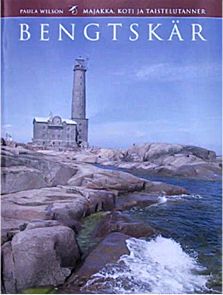
The Bengtskär book
Bengtskär-book: There is a book about the Bengtskär Lighthouse available, written by Paula Wilson and published in 2001 by Schildts Publishing. It’s only in Swedish and Finnish and is for sale at the Bengtskär lighthouse, the Rosala Viking Centre and by mail order directly from Bengtskär Ltd. The price is 42,00€ + shipping (price may have changed so check)
 Copyright secured by Digiprove © 2013 Alternative Finland
Copyright secured by Digiprove © 2013 Alternative Finland



One Response to Bengtskär Lighthouse Hotel – a uniquely Finnish experience